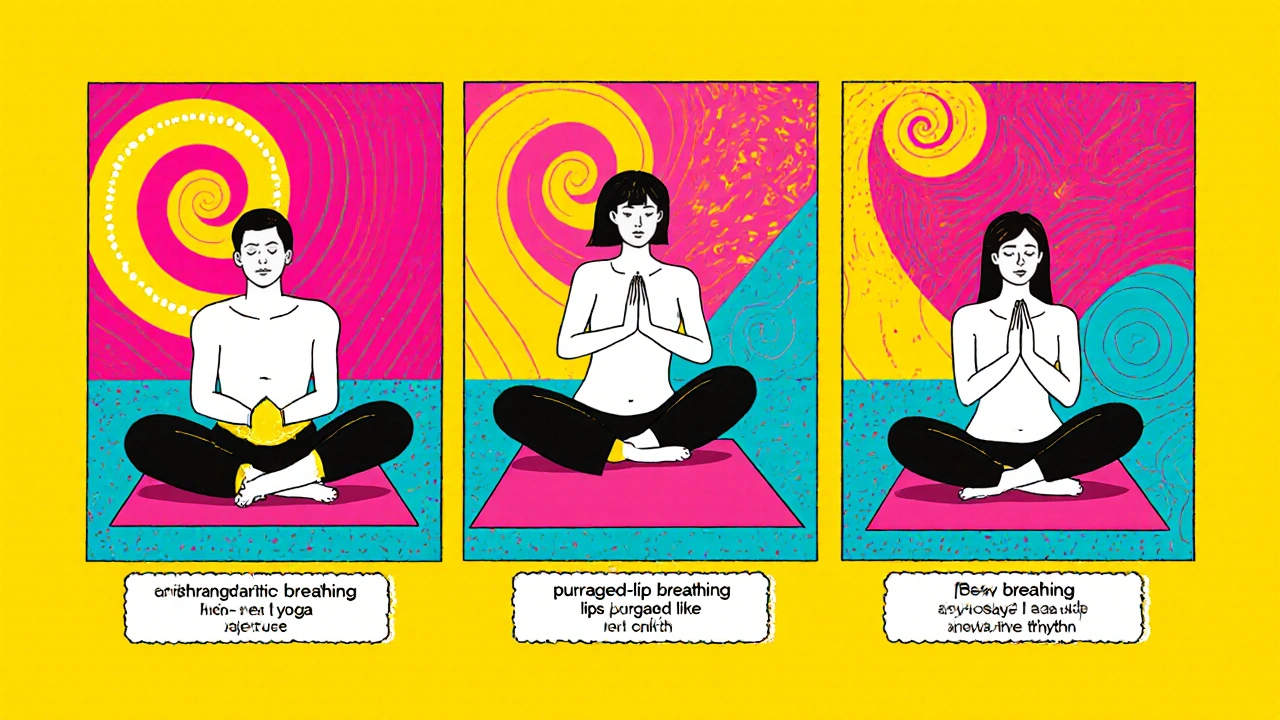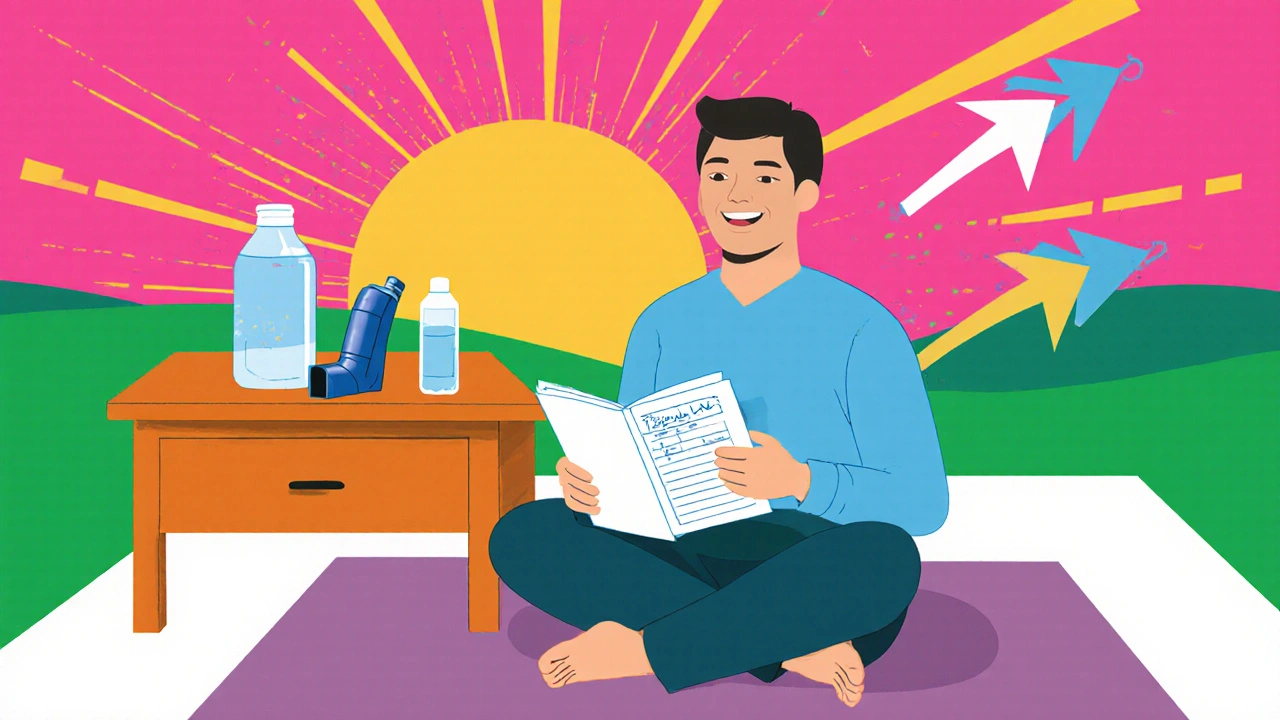Living with COPD means every breath can feel like a battle. While inhalers such as tiotropium bromide keep the airways open, adding a gentle yoga practice can smooth the way to easier breathing. This guide shows how the medication and breath‑focused yoga work side‑by‑side, walks you through safe routines, and answers common concerns.
What Is Tiotropium Bromide?
Tiotropium bromide is a long‑acting muscarinic antagonist (LAMA) inhaled once daily to relax airway muscles. First approved in 2004, it is delivered via a soft‑mist inhaler (Respimat) or a dry‑powder device (HandiHaler). The drug blocks the action of acetylcholine, reducing bronchoconstriction and lowering the risk of flare‑ups. Patients typically notice steadier airflow within a few days, and the effect lasts up to 24 hours.
Why Yoga Makes Sense for COPD
Yoga is a mind‑body practice that blends postures, breathing exercises, and meditation. For people with COPD, the breath‑work (pranayama) component is the star. Slow, diaphragmatic breathing improves lung expansion, strengthens the diaphragm, and helps regulate the autonomic nervous system, which can lower heart rate and anxiety during an attack.
How the Two Complement Each Other
- Medication stabilises the airway: Tiotropium keeps the bronchi relaxed, creating a clearer path for air.
- Yoga trains the muscles: Gentle asanas and breathing drills teach the diaphragm to move efficiently, making each inhalation more productive.
- Combined effect: Consistent inhaler use reduces baseline resistance, while yoga reduces the effort needed to breathe, leading to fewer panic‑driven flare‑ups.
Getting Started: Safety First
- Get clearance from your pulmonologist. They’ll confirm that your inhaler technique is correct and that you’re stable enough for light activity.
- Choose a quiet room with a chair, a yoga mat, and a water bottle. Warm environments can feel uncomfortable if you’re short of breath.
- Wear loose, breathable clothing. Tight sleeves can restrict chest expansion.
- Set a timer for 10‑15 minutes. Start small and grow as confidence builds.

Core Yoga Breathwork for COPD
The following three pranayama techniques are gentle enough for beginners but powerful enough to reshape breathing patterns.
- Diaphragmatic breathing (Abdominal breath): Sit upright, place one hand on the chest and the other on the belly. Inhale through the nose for a count of four, allowing the belly to rise. Exhale slowly through pursed lips for a count of six. Repeat 8‑10 cycles.
- Pursed‑lip breathing (PLB): Inhale gently through the nose for a count of two. Purse your lips as if blowing out a candle and exhale for a count of four. This creates back‑pressure that keeps airways open.
- Box breathing: Inhale for four seconds, hold for four, exhale for four, hold again for four. The rhythm calms the nervous system and trains the lungs to handle longer exhalations.
Simple Yoga Sequence (15‑Minute Routine)
- Seated Cat‑Cow (5 breaths): Sit tall, place hands on knees. Inhale, lift chest (cow); exhale, round back (cat). Moves thoracic spine and encourages full ribcage expansion.
- Seated Side Stretch (3 breaths each side): Extend one arm overhead, lean gently to the opposite side. Opens intercostal muscles for better lateral breathing.
- Supported Bridge Pose (5 breaths): Lie on back, knees bent, feet hip‑width. Lift hips slightly, place a block under sacrum for support. Keeps the diaphragm in a neutral position and eases chest tightness.
- Final Relaxation (2 minutes): Return to supine, close eyes, and practice the diaphragmatic breathing technique learned earlier. Observe any change in breath rate.
Do this routine after your morning tiotropium dose for optimal airway openness.
Comparing Tiotropium Bromide with Other Long‑Acting Bronchodilators
| Drug | Device | Once‑daily Dose | Main Benefit |
|---|---|---|---|
| Tiotropium bromide | Respimat soft‑mist inhaler | 18 µg | Strong evidence for reducing exacerbations (GOLD 2024) |
| Aclidinium bromide | HandiHaler DPI | 340 µg (twice daily) | Fast onset, good for patients who miss a dose |
| Umeclidinium | Ellipta DPI | 62.5 µg | Ease of use, low inhalation resistance |

Monitoring Progress
Combine medication tracking with a simple breathing log. Record the following after each yoga session:
- Time of day (preferably post‑inhaler)
- Number of breaths per minute (resting rate)
- Any wheeze or tightness (yes/no)
- Perceived effort on a 1‑10 scale
Over weeks, you’ll notice a lower resting rate, fewer “I can’t breathe” moments, and a higher score on the effort scale-signs that the combination is working.
Common Questions & Answers
Can I do yoga on days I miss my tiotropium dose?
Yes, but keep expectations realistic. Without the medication’s baseline airway support, you may feel more shortness of breath. Stick to the gentlest breathing exercises and avoid deep forward bends until you resume your inhaler.
Do I need a special yoga mat for COPD?
A standard, non‑slip mat works fine. The key is stability, so choose a mat with a good grip to prevent falls during seated poses.
Will yoga replace my need for tiotropium?
No. Yoga supports breathing muscles but does not relax airway smooth muscle like a LAMA does. Continue the inhaler as prescribed and use yoga as an adjunct.
How often should I practice the routine?
Aim for 5‑10 minutes each morning after your dose and a brief 5‑minute session before bedtime to calm night‑time symptoms.
Is it safe to combine other COPD meds with yoga?
Yes. Most COPD therapies (LABA, inhaled steroids, phosphodiesterase‑4 inhibitors) do not interfere with breathing exercises. Always discuss any new activity with your healthcare team.
Next Steps If You Hit a Roadblock
Even with the best plan, setbacks happen. Here’s a quick troubleshooting guide:
- Increased wheeze after yoga: Pause the session, use your rescue inhaler, and note the episode. If it repeats, consult your doctor-dose adjustment may be needed.
- Joint pain during poses: Switch to chair‑based variations. The breath work remains effective without full‑body weight bearing.
- Forget to take tiotropium: Set a phone alarm at the same time each day. Pair it with a visual cue (e.g., placing the inhaler by your toothbrush).
Remember, the goal isn’t perfect performance; it’s smoother breathing and fewer flare‑ups. Combining a proven bronchodilator with mindful movement gives your lungs a two‑pronged boost-one chemical, one mechanical.
Quick Takeaways
- Tiotropium bromide provides 24‑hour airway relaxation; use it daily as prescribed.
- Gentle yoga breathwork (diaphragmatic, pursed‑lip, box breathing) trains the diaphragm and reduces anxiety.
- Start with a 10‑minute seated routine after each inhaler dose; gradually increase to 15 minutes.
- Track breathing metrics and symptom scores to see real progress.
- If symptoms worsen, adjust medication or modify the yoga intensity-always keep your clinician in the loop.





Tamara Schäfer
October 25, 2025 AT 13:27Breathing easy feels like a smal victory.
Shannon Stoneburgh
October 26, 2025 AT 18:33Honestly, most people think yoga will magically cure COPD, but without proper med adherence it barely does anything.
Nathan Comstock
October 28, 2025 AT 03:53Look, if you’re not taking your tiotropium like a true American patriot, you might as well not bother with any of this yoga nonsense.
Terell Moore
October 29, 2025 AT 14:36Ah, the noble art of combining a pharmaceutical LAMA with ancient breathwork-how delightfully pretentious. One might imagine that the mere act of inhaling through a Respimat transforms you into a zen master, but reality is far less poetic. The inhaler delivers a precise dose of tiotropium, relaxing smooth muscle, while the yoga practitioner attempts to coax the diaphragm into graceful motions. In theory, the synergy is appealing, yet the evidence is largely anecdotal, wrapped in a veneer of wellness branding. Moreover, the recommended “10‑minute” routine sounds more like a marketing slogan than a clinically validated protocol. Patients often report minimal change in spirometry values after weeks of diligent practice, which raises questions about cost‑effectiveness. If you’re hoping for a dramatic reduction in exacerbations solely from seated cat‑cow stretches, you’ll be sorely disappointed. The truth is that medication adherence remains the cornerstone of COPD management. Yoga can complement, but it cannot replace the pharmacologic pathway that tabulates inhaled anticholinergic activity. Some clinicians argue that adding breathwork may improve quality‑of‑life scores, yet such outcomes are subjective. It’s also worth noting that improper technique-like over‑arching the back-could aggravate musculoskeletal pain, detracting from the intended benefit. Therefore, a balanced approach, with physician oversight, is advisable. In short, consider yoga as an adjunct, not a panacea. And remember, the soft‑mist inhaler will not magically sync with your pranayama unless you respect dosage timing. Finally, keep a log; data beats optimism every time.
Amber Lintner
October 30, 2025 AT 22:33Sure, “small victory” sounds cute, but let’s be real-if you’re still wheezing after your yoga session, it’s just a coincidence.
Lennox Anoff
November 1, 2025 AT 07:53While the eloquent critique highlights legitimate concerns, one must also consider the ethical responsibility to offer patients holistic options, lest we reduce care to mere pill‑popping. The moral dimension of encouraging mindful movement, even if modestly effective, aligns with a broader view of patient autonomy. Yet, we cannot ignore that resources are finite, and promoting unproven practices may divert attention from essential therapies. Therefore, a judicious integration, guided by evidence and compassion, is the prudent path forward.
Olivia Harrison
November 2, 2025 AT 18:36Great guide! I’ve been using tiotropium daily and added the seated breathing drills. After a couple of weeks I notice my resting breath rate has dropped a bit, and I feel less anxious during flare‑ups. Keep sharing these practical combos.
Bianca Larasati
November 4, 2025 AT 02:33That’s awesome to hear! Remember, consistency is key-make the 10‑minute routine a habit, and you’ll keep seeing those improvements.
Corrine Johnson
November 5, 2025 AT 13:16Honestly, the integration of pharmacology and yoga seems, well, overly simplistic; however, one must acknowledge, the holistic approach does offer, at least, a marginal benefit, if any;
Sarah Keller
November 7, 2025 AT 00:00We can agree that any step toward better breath control is worthwhile; the combination may not be a cure‑all, but it empowers patients to participate actively in their own care, which is fundamentally important.